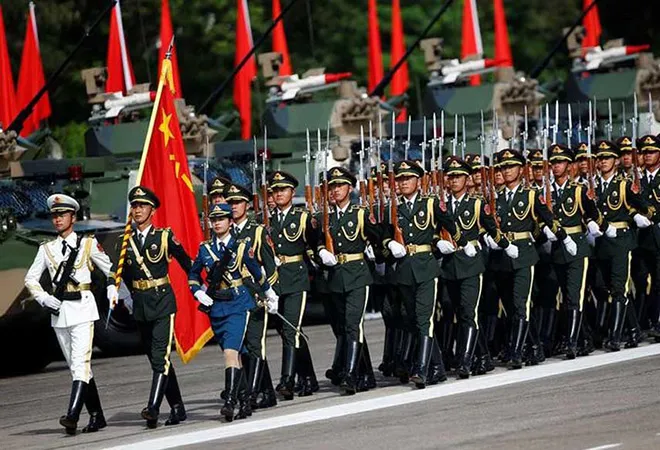
The Chinese People’s Liberation Army (PLA) celebrated its 96th foundation anniversary on 1 August. It was formed after the 1927 rebellion, also known as the
Nanchang Uprising, when the 20,000-strong insurgent army overcame the defending force of 3,000 and took control of Nanchang City. The Nanchang Uprising fired the first shots of armed Communist resistance against Chiang Kai-shek’s Kuomintang, demonstrated the Communist Chinese Party’s (CCP) firm resolve to continue the “revolution”, and also marked the birth of the Chinese PLA. Today, 96 years after the formation of the PLA and eight years into the latest military
reforms initiated by the Central Military Commission (CMC) Chairman Xi Jinping in 2015, the PLA has already turned into one of the strongest armies in the Indo-Pacific region.
The Nanchang Uprising fired the first shots of armed Communist resistance against Chiang Kai-shek’s Kuomintang, demonstrated the Communist Chinese Party’s (CCP) firm resolve to continue the “revolution”, and also marked the birth of the Chinese PLA.
During the 19
th Party Congress in 2017, Xi
added mechanisation by 2020, informatisation by 2035 and conversion of the Chinese armed forces into a world-class force by 2050 as three significant targets for the PLA. Furthermore, in 2021, a short-term
milestone was added to this list, to “ensure the achievement of the 2027 centennial military building goal”—
nian shixian jianjun bainian fendou mubiao—for marking the 100
th founding anniversary of the PLA and ensuring that China’s military modernisation campaign stays on track. Some scholars have also
interpreted this as Xi’s attempt to prepare the PLA for the annexation of Taiwan by 2027.
After eight years of ongoing reforms, as the PLA slowly enters the second stage of the reform process, the nature of the Chinese military reforms has evolved, and the emphasis today is more on the human side rather than organisational changes. There are four critical aspects to China's military reforms in the next five to seven years. First, unlike the widespread belief that the PLA's military modernisation would eventually slow down, China's military has experienced a dramatic buildup in recent years, partly owing to soaring defence budgets. This is despite the relative slowdown in its economy, especially since the pandemic. From 2000 to 2016, China's military budget
increased annually by about 10 percent, although this growth slowed to about 5–7 percent yearly recently. Its latest 2023 defence budget
marked an increase of 7.2 percent, roughly 1.55 trillion yuan (US$224 billion)—double the figure from 2013. This is also slightly up from last year's 7.1 percent rate of increase, marking the eighth consecutive year of a single-digit percentage point increase. Furthermore, China has a reputation for manipulating and withholding data, which also reflects in its defence spending. Thus, the break-up of the defence data is extremely ambiguous, and it's difficult to determine whether the Chinese strategic arsenal, militia, cyber capabilities, R&D and military tech are funded under the existing defence budget. However, despite the relative economic slowdown, the PLA has continued procuring more modern heavy metal platforms and systems that are central to achieving the PLA's stated and revealed goals. This
includes advanced submarines, cruisers and destroyers, stealth fighters, light battle tanks, and newer strategic missile capabilities.
The break-up of the defence data is extremely ambiguous, and it's difficult to determine whether the Chinese strategic arsenal, militia, cyber capabilities, R&D and military tech are funded under the existing defence budget.
But along with force modernisation, lately, the emphasis is also shifting towards personnel behind the machine. This is partly due to the demand-supply mismatch as the talent supply to man advanced Chinese equipment is insufficient. This is the reason for China’s recent adjustment in conscription requirements, which now
emphasises recruiting college-educated and technologically-oriented personnel and increasing benefits and pay to attract more capable recruits from a diverse section of Chinese society. Furthermore, Xi Jinping has also emphasised personnel policy modernisation as one of the key elements to transform the PLA into a world-class force by 2049. This is reflected in the number of recent changes, such as the 2021 switch to a two-cycle annual conscription system, changes to the recruitment of the enlisted force, alterations to the office corps education system, modifications in the roles and responsibilities of non-commissioned corps, and adjustments to the reservist system.
The force modernisation and personnel quality improvement are aimed at achieving the goals
highlighted by the CMC in November 2020 military document, titled the “Chinese People’s Liberation Army Joint Operations Outline (trial)
(zhongguo renmin jiefangjun lianhe zuozhan gangyao (shixing). This top-level law clarifies issues regarding ‘which wars would China face and how to fight them’ from the system level and how the PLA should “focus on the new situation and new problems of joint operations.” Put simply, it is an outline for the PLA to understand how to perform integrated joint operations under informatised conditions and local/regional wars with modern equipment and available force at the helm.
Xi Jinping has also emphasised personnel policy modernisation as one of the key elements to transform the PLA into a world-class force by 2049.
Finally, since 2021, the PLA has also started to focus on defence mobilisation, which it considers an essential means of allowing maximum peacetime development of locally available resources that can be exploited during a conflict or escalation. This includes
creating and empowering National Defence Mobilisation Offices (NDMOs) at local levels and empowering them to mobilise forces and resources during an escalation, and also helping the PLA with logistics and establishing coordination between the military and civilian agencies.
Besides force modernisation, personnel policy reforms, achieving integrated joint operations capabilities, and reforming China mobilisation systems, the PRC has continued to invest in its strategic arsenal, cyber and space capabilities, strategic logistics capabilities and amphibious warfare and border defence capabilities, and it looks like this will continue for the next five to seven years. Thus, at 96, after eight years of relentless ongoing military reforms, with no signs of slowing down, the continued investment in reforms implies a seriousness in achieving China’s national security objectives.
Suyash Desai is a research scholar studying China’s defence and foreign policies.
The views expressed above belong to the author(s). ORF research and analyses now available on Telegram! Click here to access our curated content — blogs, longforms and interviews.



 The Chinese People’s Liberation Army (PLA) celebrated its 96th foundation anniversary on 1 August. It was formed after the 1927 rebellion, also known as the
The Chinese People’s Liberation Army (PLA) celebrated its 96th foundation anniversary on 1 August. It was formed after the 1927 rebellion, also known as the  PREV
PREV


